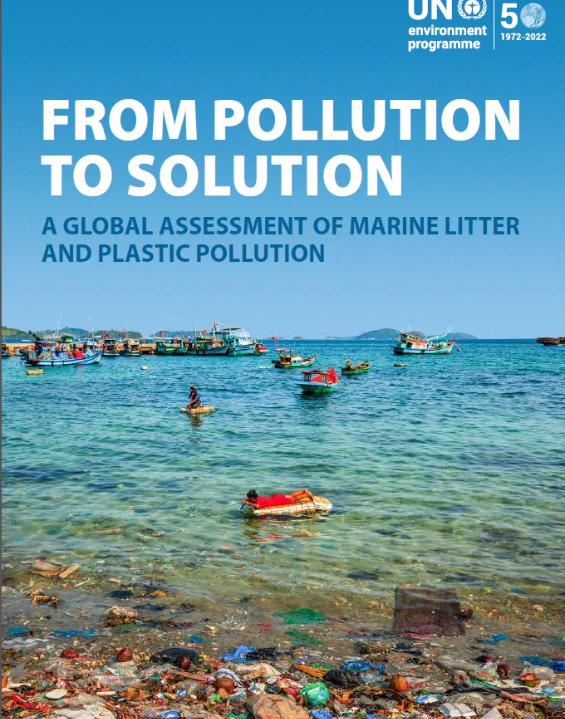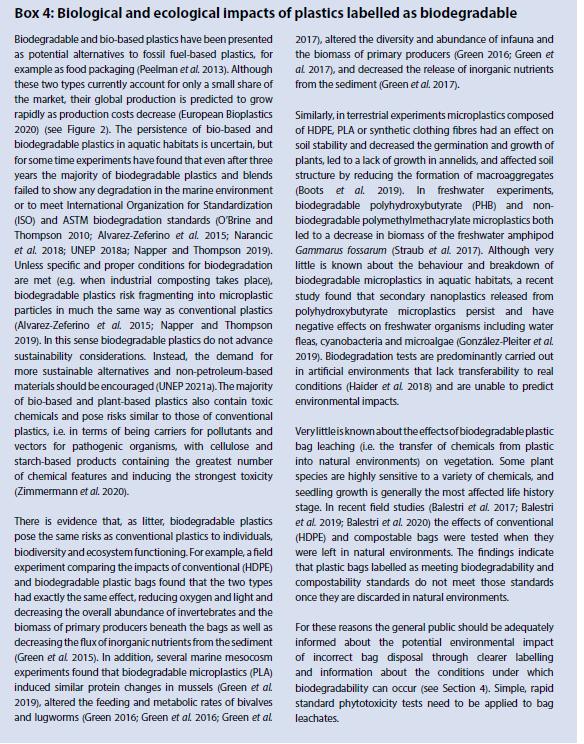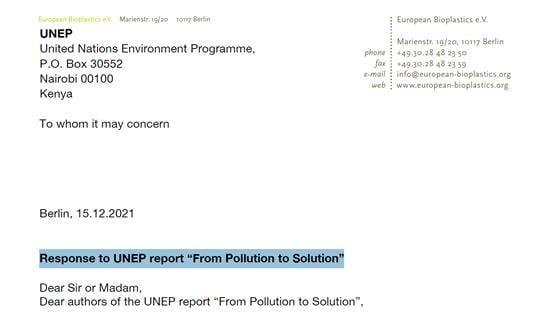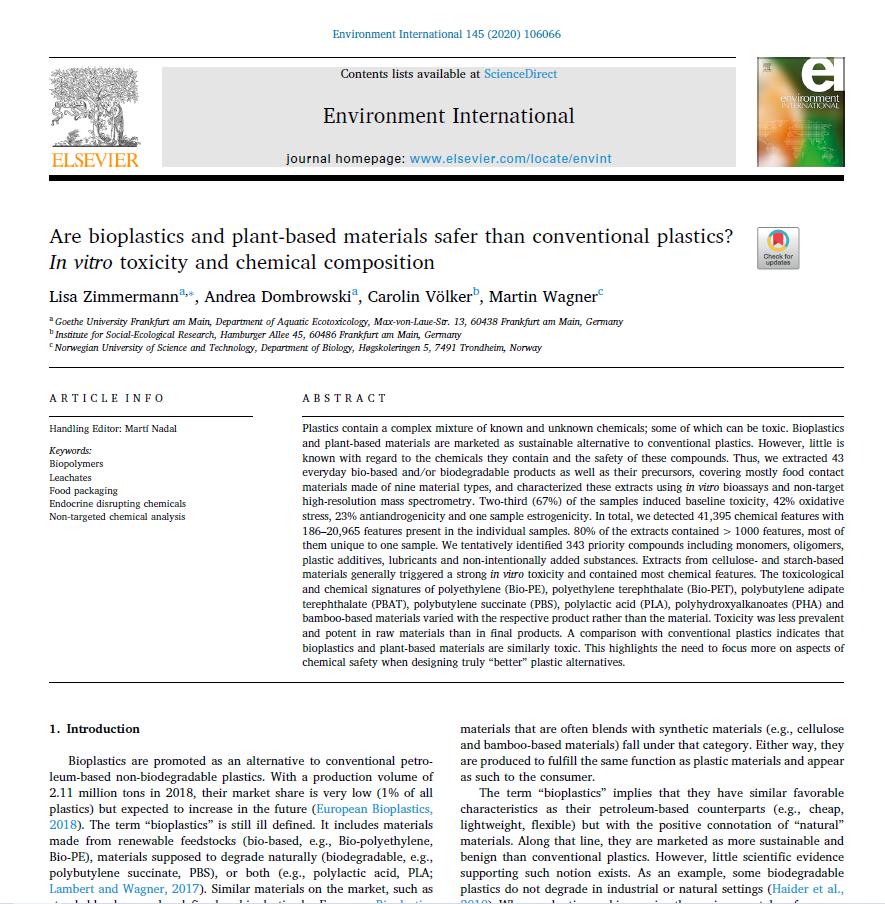In October 2021, UNEP released the report "From Pollution to Solution: a global assessment of marinelitter and plastic pollution" to the world. However, some comments of the report about biodegradable plastics and bio-based plastics may be controversial due to the angle and lack of comprehensiveness of the comments.
UNEP PK FAO: Biodegradable plastics, who is lying?


On December 15, 2021, the European Bioplastics Association (EUBP) commented in an open letter to the public in response to the United Nations Environment Programme's globally released report, From Pollution to Solutions: A Global Assessment of Marine Litter and Plastic Pollution.

EUBP began by welcoming UNEP's long-term efforts in promoting a transition to a low-carbon, resource-efficient and environmentally risk-reducing economy.
But EUBP says that despite the many benefits of bioplastics in helping to reduce, reuse and recycle waste, misconceptions and prejudices about bio-based, biodegradable and compostable plastics persist. As the recent UNEP scientific assessment, "From Pollution to Solutions - A Global Assessment of Marine Litter and Plastic Pollution" and the complementary report "Drowning in Plastic - A Global Assessment of Marine Litter and Plastic Pollution," show, there is no doubt that biomass is a major source of pollution. -A Critical Map of Marine Litter and Plastic Waste," both of which were released earlier in 2021.
EUBP believes that both reports show a lack of understanding of the nature and properties of bioplastics and, as a result, draw erroneous and highly misleading conclusions about their impact. These reports lack an understanding of the innovative properties of bioplastics and ignore recent developments, the latest scientific evidence and standardization efforts. This is inconsistent with the UN's commitment to reduce dependence on fossil resources, greenhouse gas emissions and the environmental impact of plastics.
Therefore, EUBP wanted to address some of the most problematic areas identified in the report and provide a more balanced understanding of bioplastics.
(1). Definition of bioplastics and proper use of terms
Throughout the report, various terms are used to refer to the origin of bioplastics, including "bio-based," "bio-sourced," and "plant-based," which only leads to more confusion about what bioplastics are, not less. This only leads to more confusion about the meaning of bioplastics, not less. To the casual reader, these terms mean exactly the same thing. Unlike "bio-sourced" plastics, "bio-based" plastics may be entirely fossil-based (and may be biodegradable), which is unreasonable.
Therefore, EUBP strongly recommends using the most common and widely accepted definition of bioplastics: "Bioplastics are either bio-based, biodegradable, or both." These terms are defined and clearly described in the European Standard EN 16575 developed by CEN/TC411 WG 1.
As correctly stated in the report, the term "bioplastics" should not be used to describe a specific material without reference to its source (based or non-biological) and its intended end-of-life options. Similarly, the terms "biodegradable" and "compostable" should not be used alone as general end-of-life statements, but should always be specified by the target environment (e.g., industrial compost, home compost, agricultural soils) in terms of the time frame in which biodegradation can occur and/or specific criteria for setting corresponding thresholds. or specific criteria for setting corresponding thresholds.
(2). Properties and advantages of bio-based plastics
The two reports released by UNEP completely ignore the main advantages of bio-based plastics, namely removing bio-carbon from the atmosphere, storing it in materials/products, and preventing carbon from contributing to climate change. This is significantly better than petrochemical-based plastics, where fossil carbon stored underground for millions of years is extracted and eventually emitted into the atmosphere, negatively impacting the climate. Bio-based products replace fossil carbon and reduce greenhouse gas emissions. This fact must be taken into account when making a fair and balanced assessment of environmental impacts. However, it is not mentioned in the report.
Instead, the two reports state, "Overall, replacing one disposable product (e.g., made of plastic) with another made of a different material (e.g., paper, biodegradable plastic) will only shift the environmental burden and create other problems." (UNEP, From Pollution to Solutions, p. 101).
It is true that the priority to reduce pollution should be to reduce the number of disposable products to the absolute minimum necessary, but bioplastics still have an advantage over conventional plastics because they are either bio-based or biodegradable (compostable), or both. In this way, while it may not be possible to completely eliminate the environmental burden, they will certainly reduce it without shifting any of it.
(3). Biodegradation behavior under different environments
To assess the benefits or impacts of biodegradable plastics, the report references the following studies and conclusions: "In their review of the biodegradability of plastic bags, Harrison et al. conclude that current international standards and regional testing methods are insufficient to realistically predict the biodegradability of hand-held plastic bags in wastewater, inland waters (rivers, streams and lakes) due to the shortcomings of plastic bags and marine environments for biodegradability.
Existing testing procedures, the lack of relevant standards for most unmanaged aquatic habitats, and the lack of broader research on the biodegradation of plastic materials under real-world conditions." (UNEP, From Pollution to Solutions, p. 79).
However, this reference is very problematic because it completely ignores the clear recommendation that in order to declare the biodegradability of a product, environmental conditions must be specified and a time frame for biodegradation must be set in order to make the declaration measurable and comparable. This is provided for in the applicable standards. There are specific applications in which compostable and organic recycling properties represent ecological improvements: 1) applications that promote biological waste collection and composting; easily contaminated compost; 2) and/or those that cannot or are not easily recycled. because they are: a) contaminated with food waste; b) too small to be collected, sorted and cleaned prior to recycling; c) made of non-separable multi-layer films; or d) otherwise difficult to recycle. These applications should also be made of compostable plastics, as organic recycling provides a valuable end-of-life option. Closed-loop systems can work well by allowing compostable packaging to be collected along with food waste in situations where reuse is not appropriate. In order to be suitable for organic recycling, products and materials need to meet the strict criteria of the European standard EN 13432 on industrial compostability.
However, these reports ignore the need for these specifications and further note that "in recent field studies (Balestri (2017, 2019, 2020), the impact of conventional (HDPE) plastic bags and compostable plastic bags was tested. When they are left in the natural environment, the findings show that plastic bags labeled as meeting the criteria for biodegradability and compostability do not meet these criteria once they are discarded in the natural environment." (UNEP, From Pollution to Solutions, p. 31).
Coming to such a conclusion is not only extremely misleading, but it also unknowingly promotes the idea that such products may be littered. This is problematic because it leads to the opposite result.
Since it is clearly not possible to scientifically standardize the "natural environment", biodegradability cannot be tested in such environments. This in no way affects the added value of certifying plastic bags as industrial or home compostable.
If a plastic bag meets industrial compostability standards such as EN 13432, it is ideally suited for collecting biological waste and composting with its contents in an industrial composting facility. Neither the material nor the application is designed to degrade in a "natural" environment.
The report further states, "While biodegradability may be an advantage of PLA and some other bio-based plastics in reducing the number of landfills, few cities and communities have the infrastructure needed to compost under the right conditions. Organizations that use compostable biopolymers may continue to send their waste to landfills (UNEP 2021b). For the more common bio-based and biodegradable plastics, this may be a major problem. (UNEP, From Pollution to Solutions, p. 101)
Given the commitment to waste reduction and increased recycling, does the above statement justify the need for an effective waste infrastructure to avoid bio-waste ending up in landfills and releasing methane there, a greenhouse gas more than 20 times more powerful than carbon dioxide, rather than rejecting altogether innovative solutions that offer many other benefits?
(4). Biodegradation behavior in the marine environment
Biodegradability in the open environment (especially in the ocean) is only applicable to a very few, highly specific applications. These may be plastic wastes that are difficult to find and recover, such as fireworks shells, or plastic products used by professionals (e.g. farmers or fishermen/fishermen) in specific situations (e.g. fishing line nets). For other applications that fall primarily under the category of packaging, "biodegradability in an open environment" is neither promoted nor endorsed, and the industry fully agrees that this principle should not be changed.
However, if a comprehensive assessment of the persistence of items causing littering consequences is to be conducted, a risk assessment should be conducted for all materials found in the open environment.
In this regard, the report refers to the following publication, "The persistence of bio-based and biodegradable plastics in aquatic habitats is uncertain, but experiments over time have found that even after three years, most biodegradable plastics and mixtures fail to demonstrate any degradation in the marine environment or meet International Organization for Standardization (ISO) and ASTM biodegradation standards." However, the criteria mentioned in the report kind are not explicitly passed-fail criteria for the test methods. Therefore, it is meaningless to say that they do not meet these criteria.
At the same time, some of the papers in the report failed to test certified materials or test industrial compostable materials, or worse, none of them tested oxidatively degradable materials.
Therefore, the results of these publications cannot be used to make such a generalized statement. On the other hand, the report does not mention that several biodegradable plastics and blends (e.g., TPS, PHB, PHB-PLC blends, etc.) showed good marine biodegradability as indicated in the article by Narancic et al.
Currently, there are no international standards that adequately define the biodegradation of plastics in the marine environment. However, many standardization projects are underway at the ISO and ASTM levels. While biodegradable plastic is not and never will be the solution to marine litter according to established standards, it may be part of the solution.
EUBP fully supports additional research on the biodegradation behavior of existing material types and applications and calls for criteria to measure and confirm (or reject) biodegradation claims in the respective marine environments as already achieved with biodegradable materials.
(5). Risk of microplastics
The advantage of biodegradable materials is that they do not erode into permanent secondary microplastics as they degrade because most natural environments are inhabited by microorganisms capable of metabolizing these polymers. As a result, biodegradable materials have a much shorter residence time in the environment compared to conventional plastic materials. In this way, biodegradable plastics help to minimize the environmental impact and reduce the accumulation of plastic particles in different environmental habitats. However, the report incorrectly claims that "biodegradable plastics do not degrade into microplastic particles like conventional plastics (Napper and Thompson 2019)." (UNEP, From Pollution to Solutions, p. 55) Not only is the statement misleading, but the study it refers to (Napper, IE and Thompson, RC (2019), Environmental Science and Technology 53(9), 4775-4783.) contains many flaws and is therefore disqualified. The main point of criticism from academics is that they deliberately draw general and erroneous conclusions about "biodegradable" bags from bags that claim to be biodegradable, but clearly are not.
EUBP strongly recommends that a careful distinction always be made between biodegradable and compostable. When testing compostable plastics for marine biodegradation, the conclusions of these tests lack any justification. Biodegradable and compostable plastics, when used in their designed applications, do help reduce the risk of microplastic contamination. They are metabolized to CO2, H2O and biomass and decomposed in less than 12 weeks. In this case, decomposition is a necessary part of the overall biodegradation process and the formation of smaller particles, which should not be confused with persistent microplastics that will remain in the final compost. Even in the case of sub-optimal composting treatment, the biodegradation process of the decomposed plastic small particles does not stop at this point, but continues in the soil.
EUBP supports all efforts to better understand the origin and production of microplastics and their release into and impact on the environment, minimizing the impact of plastics on the environment. Scientists are investigating the options of biodegradable materials as potential solutions for microplastic accumulation. Therefore, data on the residence time of the material in nature should also be included in the risk assessment of the LCA.
(6). Risk of littering (ecotoxicity)
Biodegradable and compostable plastics have never been designed to be discarded in the open environment. However, in order to address this issue, it is necessary to distinguish between waste that is intentionally released into the environment and waste that is discarded due to "accidental spills/littering". In the first category, there are only a limited number of applications, such as fishing gear and fireworks casings, to name a few. In addition, soil biodegradable mulches that improve agricultural productivity also fall into this category. These criteria were developed to ensure complete biodegradation and integrated ecotoxicity testing that takes into account all relevant exposure pathways. As described for composting, soil biodegradable mulch helps reduce microplastics in agricultural soils. Unlike conventional mulch made of PE, which can lead to a buildup of plastic in the soil - even after planting has stopped - soil biodegradable mulch does not lead to a buildup in the soil.
However, if littering means "accidental spills", a risk assessment should be conducted to examine not only biodegradable and compostable plastics, but also all plastics and other materials (glass, paper, metal, etc.), as there is no evidence that compostable products are more dispersed in the environment than any other material. In many cases, media reports portray compostable packaging as a popular innovation for every application and the primary solution to marine plastic pollution, which is incorrect. In other cases, compostable packaging is portrayed as not truly compostable, which is also incorrect. Policymakers, academia, and industry must continue to work to understand the intersection of food waste, composting infrastructure, and ocean pollution systems, and to communicate the facts clearly and accurately.
EUBP believes that sound, well-functioning, source-separated waste collection is one of the most important measures to combat littering. All types of waste should find their way into appropriate and controlled forms of waste management and recycling.
(7). The safety of bio-based plastics has been proven
This is particularly important when the safety of bioplastics and additives has long been established according to EU environmental and human health safety standards. For example, products that want to be certified as compostable according to the European standard EN 13432 need to pass a rigorous ecotoxicity test. It should also be noted that some biodegradable polymers are considered safe because they are also used in biomedical applications, indicating that their safety for human health has been thoroughly investigated.
(8). Land use and sustainable sources of raw materials
Many of the raw materials used to produce bio-based plastics have been used for industrial purposes for almost a century. For example, the EU starch production from corn, wheat or potato is 10.7 million tons (2019), of which the EU consumes 9.2 million tons of starch (excluding protein and fiber, totaling about 5 million tons), of which 56 % is used for food, 3 % for feed and 41 % for non-food applications, mainly paper (31 %). Bio-based plastics account for less than 5% of starch consumption in the EU and fall under the category of "other non-food applications" (source: Starch Europe). Therefore, with regard to sustainability criteria for bio-based plastics, the focus is not on the type of raw material used, but on the amount of land required to produce the main raw material. According to recent data, the bio-based plastics industry does not compete with food and feed production. The land used to grow renewable feedstocks for bioplastics production is estimated at 0.013% of the global agricultural area of 5 billion hectares (in 2020). Although the market is expected to grow over the next five years (2021-2026), the land use share of bioplastics will increase to only about 0.06% by the end of this period. (Source: European Bioplastics and Nova Institute, 2021)
(9). Clarification of labels
All plastic products (traditional petrochemical-based plastics and bioplastics) should be the subject of comprehensive education and awareness campaigns to ensure proper disposal and end-of-life treatment. Compostability complements other waste management processes, especially for materials that are otherwise difficult to recycle. Biodegradable/compostable plastics should not be judged or evaluated based on their behavior in a non-compostable environment, as it is already perfectly possible to separate and process these plastics mechanically or organically.
EUBP believes that both the bio-based content and compostability of plastics should be clearly and uniformly labeled.
Overall, EUBP believes that the assessments and conclusions of the two UNEP reports on bioplastics represent an inadequate and very misleading portrayal of these innovative materials. They also jeopardize the potential for innovation in the field of plastic substitutes and bio-based products. By ignoring the important aspects and advantages of the bioplastics sector, they strongly support the status quo of traditional fossil plastics. This is a serious obstacle to the commitment and goal of replacing fossil carbon and reducing greenhouse gas emissions and environmental impact. EUBP therefore urges the UN to reconsider its position on bioplastics and update the report - while halting wider dissemination - to take into account the latest scientific research and set the same high bar for traditional fossil plastics as it does for mandated, innovative bio-based materials .
Comments on the United Nations Environment Programme report
In October 2021 UNEP released the report From Pollution to Solutions: A Global Assessment of Marine Litter and Plastic Pollution, citing some of the articles in its Box 4 section of the report (O'Brine and Thompson 2010; Alvarez-Zeferino et al. 2015; Narancic et al. 2018; UNEP 2018a; Napper and Thompson 2019; Zimmermann et al. 2020.) In an article published in Elsevier's journal Environment International, Zimmermann's group at the University of Frankfurt, Germany, conducted extraction and in vitro cellular toxicity studies on 43 everyday bio-based and/or biodegradable products and their precursors, mainly covering food contact materials made from nine material types. Toxicity studies concluded that "existing bio-based and biodegradable plastics are no different from conventional plastics in terms of toxicity testing against organisms." This has led some to argue that "biodegradable plastics, like conventional plastics, do not contribute to the improvement of the marine and terrestrial environment and are equally harmful to humans.

A careful reading of the article revealed that.
The paper investigates the harmfulness of bio-based plastics/biodegradable plastics themselves to cells in an in vitro environment, not for testing the toxicity of their degradation products to cells. This paper does not study the corresponding chemical characterization markers and related toxicological tests (including but not limited to baseline toxicity tests, oxidative stress tests, endocrine activity tests) for degradation products such as PLA, PBAT, starch-based plastics, and bamboo fiber-based plastics
The plastic extraction method in this paper was performed by dissolving in methanol and extracting in an environment of sonication at room temperature, while the extract was later added directly to the medium containing the cells. This method is equivalent to injecting plastics directly into the human body. It is impossible to prove that bio-based plastics/biodegradable plastics have direct harmful effects on the marine environment or terrestrial environment, but only that bio-based plastics/biodegradable plastics products themselves contain biologically harmful chemical components, which can actually be completely avoided from the synthetic processing side.
The main idea of the paper is to emphasize to the public that bio-based plastics \ biodegradable plastics may also have the risk of containing chemicals that are harmful to humans, and therefore the chemical safety issues must be addressed when targeting the production and marketing of food-grade bio-based plastics/biodegradable plastics. In its conclusion section, the authors of this paper argue that in the development of new bio-based and biodegradable materials, the chemical safety of the materials can be further optimized using green chemistry to remove toxic components from the products by artificial means. This article is more about communicating to the public that we should produce "food-grade bio-based plastics and biodegradable plastics that are safer for humans" rather than denying bio-based plastics and biodegradable plastics.
As seen above.
The report released by the United Nations Environment Programme (UNEP) does not completely reject bio-based plastics/biodegradable plastics, but some of its contents are easily misunderstood and quoted out of context by some people who do not conduct in-depth research and publish their views, causing the public to think that "bio-based plastics/biodegradable plastics do not improve the environment and reduce carbon emissions. This has led to the misunderstanding that "bio-based plastics/biodegradable plastics do not improve the environment and reduce carbon emissions.

